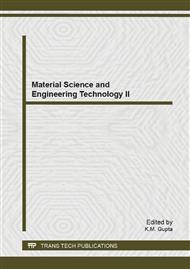p.9
p.16
p.22
p.25
p.29
p.36
p.43
p.48
p.53
Study on the Dense-Packing Effect and Properties of Multi-Component Cementitious Material
Abstract:
The paper studied the effects of single addition of ultrafine fly ash (UFA) and mixed addition of silica fumeultrafine fly ash (SF-UFA) on powder pressure entity dense packing density, mechanical performance and microstructure structure of composite cement paste. The results show that, the ternary system of mixed addition of SF-UFA can effectively further reduced the compacting voidage and more increased packing density of composite powder, compared with the binary system of single addition of UFA. And when the content of SF is 8%, the compacting voidage is the lowest. Next, in the ternary system of mixed with silica fume, ultrafine fly ash and cement (SF-UFA-C), with the increase of silica fume (SF), the total porosity and pore diameter of hardened cementing paste decreased further compared with binary system, and with 8% content of SF and 17% content of UFA, the total porosity of hardened cement paste is the lowest, decreased by 60% than that of reference sample. At last, mixed addition of SF-UFA can improve the long-term strength of composite cement paste either, the compressive strength of 60 days hydration increased by nearly 9% compared with UFA-C and increased 41% compared with the reference sample.
Info:
Periodical:
Pages:
29-35
Citation:
Online since:
December 2013
Authors:
Price:
Сopyright:
© 2014 Trans Tech Publications Ltd. All Rights Reserved
Share:
Citation:


